by
_____
How does a company make a comeback from a terrible mistake? Let’s say, for instance, a trusted global retail bank is caught creating phony accounts to hit sales targets? Or a green automaker cheats on emissions tests?
How can a badly tarnished brand regain public trust?
Communications and thought leadership consultant Pete Weissman says sometimes a bad situation calls for a gesture so bold and counterintuitive that it transforms public perception.
One way to do that is through what he calls the “savvy sacrifice.”
That’s when a company makes a policy change or takes an unexpected step that seems to run counter to its commercial interests, but actually sets the company up for an entirely new role in which the gains outweigh the losses.
A savvy sacrifice generates opportunities that the company would not otherwise have by creating new networks, supporters and advocates, and enlisting them in a new mission. The gains of a savvy sacrifice extend beyond the company’s bottom line by bringing larger benefits to society.
Weissman considers this thought leadership strategy because it allows a company to lead through its ideas.
He gives three examples of companies facing reputational issues, and how a savvy sacrifice paid off each time.
CVS
In February 2014, CVS became the first pharmacy chain to ban the sale of cigarettes and tobacco products at its more than 7,600 stores.
Why would a company stop selling such popular and lucrative products? The company warned it could take a $2 billion annual hit in sales, and in fact its first quarter sales dropped by 8 percent.
But CVS understood its industry was changing, and that its future growth would not come from filling prescriptions and selling products. With healthcare spending on the rise, the larger play was in healthcare delivery.
After the ban, CVS gained a reputation as a committed public health advocate. “By eliminating the sale of cigarettes and tobacco products in our stores, we can make a difference in the health of all Americans,” said CEO Larry Merlo.
The company founded the CVS Health Research Institute, launched a national smoking cessation campaign, and funded a tobacco-prevention curriculum in public schools.
Now Merlo and other executives are leading the national conversation on health and wellbeing. They give speeches and lead discussions at the most prominent healthcare conferences. They’ve created new partnerships with global health organizations. And the company has won awards and other accolades.
Instead of peddling “death sticks,” it’s on the side of angels.
Tesla
Tesla Motors had been manufacturing electric cars since 2008, but the market remained small.
Company executives knew that if their sales were to grow, the market for electric cars had to grow as well. The entire electric engine sector had to dramatically expand.
But for such a niche product, there was little incentive for other manufacturers to develop the infrastructure, including better, less expensive batteries and electric charging stations.
In October 2014, chief executive Elon Musk announced in a blog that the company would be “open sourcing” its patents – that is, pledging not to sue any party that used its patented technology for electric vehicles.
Patents are usually considered invaluable – a company’s crown jewels – and giving them away for free might seem like madness.
But in this case, Musk realized the patents were holding back the marketplace. By releasing its intellectual property, the company spurred others to invest in new technologies. Letting others expand the market made sense.
“We believe that Tesla, other companies making electric cars, and the world would all benefit from a common, rapidly-evolving technology platform,” Musk wrote in his blog.
With one gesture, Tesla opened up a world of new opportunities.
Timberland
A decade ago, the New Hampshire-based manufacturer of leather boots and outdoor apparel knew the materials that went into their bootwear weren’t exactly environmentally friendly.
For a company whose products were purchased by nature lovers all over the world, it was an opportunity to differentiate Timberland from the competition, reinforce its brand promise, and do some good for the planet.
So the company decided to take the lead. In 2006, Timberland created a green packaging initiative – with a pledge to reduce its environmental impact and put a “nutritional label” found on every shoe box that listed where the footwear was manufactured, how it was produced, and its effect on the environment.
The following year, Timberland created the Green Index label. “Our goal is to reduce our impact on the environment while engaging consumers to take action,” said Jeffrey Swartz, Timberland’s president and CEO.
By putting the information at the point of sale, Timberland was giving its customers a choice – to buy from a company that was transparent, or one that was not.
It was a counterintuitive move, broadcasting to the world that its products were not helping the environment, but asking for patronage anyway.
In the months and years that followed, Timberland continued to improve its environmental record and worked with more than 40 brands as part of the Outdoor Industry Association to create an index measuring the environmental impact of outdoor products.
Timberland’s leaders spurred a new approach in their industry and changed the conversation – another example of leading with a powerful idea.
____________________
A savvy sacrifice turns a bad situation on its head. It must be counterintuitive – surprising enough to break through the negative news and grab attention. And because it generates positive press, it has the power to alter public perception.
Instead of being tied to problems from the past, the company making the sacrifice associates itself with the future and transforms its leaders into visionaries.
Note that a savvy sacrifice is not just for a company in trouble. It can also help a successful company set a new agenda for the industry. “Why play catch up,” Weissman asks, “when with a thought leadership program, you can be the one driving change?”
What company wouldn’t want that?
© Copyright 2016
________________________________
Want to talk? Reach me at dana@danarubin.com

